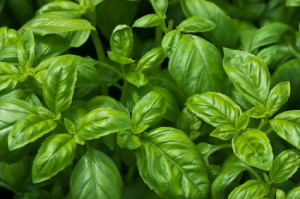Start building your herb beds with whatever bed style that you like best. Clear the bed of any weeds and debris that may have accumulated over the winter. With your hand cultivator – claw – loosen the soil down six to eight inches so that your plants will have a solid foundation. The better the foundation, the better the herb quality they will produce. Add a layer of organic fertilizer an inch deep; I use rabbit droppings, but you may use steer manure or any other organic fertilizer available. Once again using your claw cultivator, mix in your fertilizer well.
 Planting your herb garden is all a matter of taste, your taste. If you cook Italian foods, you may want to plant oregano, marjoram, basil, thyme, and Italian parsley. If you cook more chicken, turkey, and other fowl, you may want to plant lemon basil, tarragon, thyme and rosemary. You may also want to plant a baked potato herb garden with a variety of different chives. Or if you like to cook Mexican foods you may want to plant a few bushes of cilantro and cumin. Personally I like to grow lots of fresh basil, parsley, a couple kinds of mint, chamomile, and tarragon in my herb beds. I also have cilantro in my salsa garden. The herbs in your garden will only be limited by your imagination and sense of taste.
Planting your herb garden is all a matter of taste, your taste. If you cook Italian foods, you may want to plant oregano, marjoram, basil, thyme, and Italian parsley. If you cook more chicken, turkey, and other fowl, you may want to plant lemon basil, tarragon, thyme and rosemary. You may also want to plant a baked potato herb garden with a variety of different chives. Or if you like to cook Mexican foods you may want to plant a few bushes of cilantro and cumin. Personally I like to grow lots of fresh basil, parsley, a couple kinds of mint, chamomile, and tarragon in my herb beds. I also have cilantro in my salsa garden. The herbs in your garden will only be limited by your imagination and sense of taste.
All your herbs may be started from seed or by purchasing seedlings for transplanting. As our winter was so long this year, I bought most of my plants as seedlings. I do have seed for planting late-season basil and parsley.
Planting
If planting seedlings, be sure to space them well, at least six to eight inches apart. Plant these seedlings at least four inches deep, putting sixty to eighty percent of the plant underground. When planting seeds, plant the area heavily with seed and thin to six inches apart when they have their second pair of real leaves.
Harvesting
Let your plants grow until they start to put on blooms before harvesting. Pick your herbs in the morning just after the dew is dried on their leaves – this is when their essential oils are high in the leaves and their flavor and fragrance is at its peak. Wash them well before use, and if possible, wash your herbs the day before you harvest. Discard any diseased, disfigured, or insect-infested leaves.
Use your herbs fresh the same day or store in the refrigerator for a few days in zippered plastic bags. Or hang them to dry by tying them in bunches and hanging them with their bottoms up so that the flavor and fragrance stays in the leaves. Some herbs lose their flavor when exposed to air in this manner, but they will retain their flavor if they are stored in oil or in liquor. Another way to preserve your herbs is to freeze them. This is a quick and easy method, and the flavor of your herbs will be much closer to the fresh herbs than drying them. It would be wise to research which way is best for your particular herbs before storing them all.
At the end of the growing season, you will want to harvest some seed for growing the next year, so be very careful when the time comes. Your timing must be precise, as the seeds need to be picked when they are ripe but before they can be dispersed. The best way to be on top of this ripening is to check your plants on a daily basis and harvest your seeds as soon as they begin to dry. Carefully cut them off with a clean pair of kitchen scissors over a large paper bag. Allow the seeds to fall into the bag and keep them in the bag until they are completely dry. Be careful not to compact the seed heads as air circulation around these heads assures proper drying and lessens the possibility of any mold growing on them.
If you can’t keep this close a watch on your plants maturation process, the alternative is to enclose each seed head in a small paper or mesh bag once the flowering is completed and the green seeds become evident. When the heads are dry they can be clipped from the plants and any seeds that may have fallen from the heads will be captured in the bags. Now you can complete their drying process indoors.
Plant your seeds and seedlings, and add some fresh flavors to your food and your life!
 Off The Grid News Better Ideas For Off The Grid Living
Off The Grid News Better Ideas For Off The Grid Living




